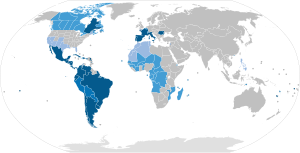
Romance languages
Modern languages that evolved from Vernacular Latin / From Wikipedia, the free encyclopedia
Dear Wikiwand AI, let's keep it short by simply answering these key questions:
Can you list the top facts and stats about Romance languages?
Summarize this article for a 10 years old
The Romance languages, sometimes referred to by these languages as Latin languages[1] or Neo-latin languages,[2][clarification needed] are numerous modern languages that evolved from Late Latin and its spoken form, often called Vulgar Latin.[3] They are the only extant subgroup of the Italic languages branch of the Indo-European language family.
| Romance | |
|---|---|
| Neo-Latin Latinate[vague] | |
| Geographic distribution | Originated in Old Latium, Southern, Western and Eastern Europe; now also spoken in a majority of the countries of the Americas, in parts of Africa and in parts of Southeast Asia and Oceania |
| Linguistic classification | Indo-European
|
Early forms | |
| Proto-language | Proto-Romance |
| Subdivisions | |
| ISO 639-2 / 5 | roa |
| Linguasphere | 51- (phylozone) |
| Glottolog | roma1334 |
 Romance languages in Europe | |
 Romance languages across the World Majority native language
Co-official and majority native language
Official but minority native language
Cultural or secondary language | |
| Part of a series on |
| Indo-European topics |
|---|
 |
|
|
Origins |
|
Archaeology Pontic Steppe Caucasus East Asia Eastern Europe Northern Europe Pontic Steppe Northern/Eastern Steppe Europe
South Asia Steppe Europe Caucasus India |
|
Peoples and societies Indo-Aryans Iranians East Asia Europe East Asia Europe Indo-Aryan Iranian |
|
|
The five most widely spoken Romance languages by number of native speakers are Spanish (489 million), Portuguese (283 million), French (80 million), Italian (67 million) and Romanian (24 million), which are all national languages of their respective countries of origin.
There are more than 900 million native speakers of Romance languages found worldwide, mainly in the Americas, Europe, and parts of Africa. The major Romance languages also have many non-native speakers and are in widespread use as linguae francae.[4]